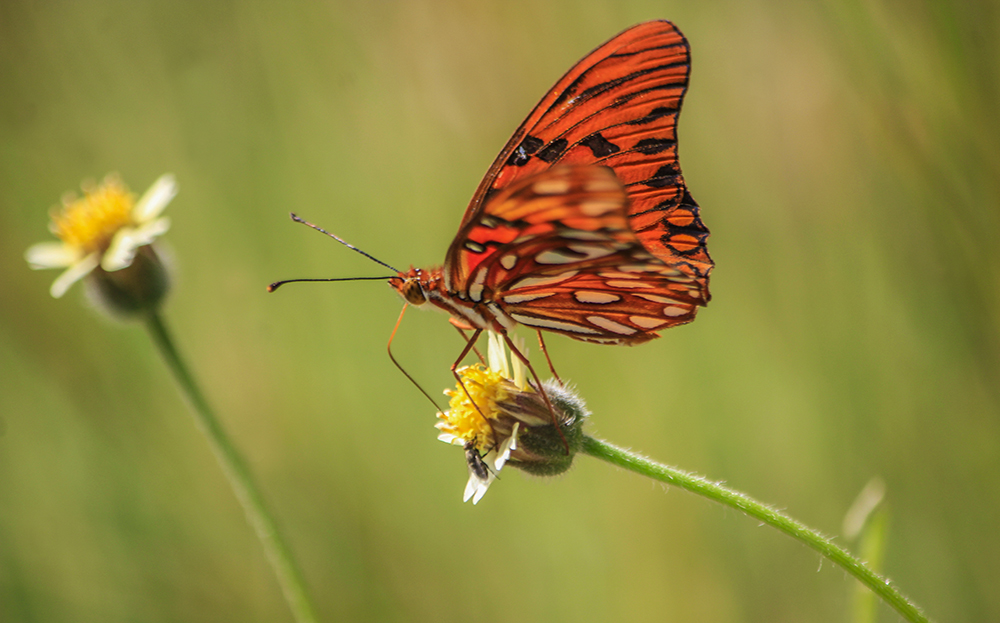Agraulis vanillae insularis sucking on cupid's tears (Russelia equisetiformis).
Hanabanilla, Guamuhaya, central Cuba.
(Right click to enlarge) Photo: Deny Extremera San Martín/ Cubadebate.
Due to their chromatic diversity and shapes, they are undisputed divas, always the most admired of the Insecta class by humans (sometimes, the smallness of other insects, the most abundant and diverse animals on the planet, prevents us from appreciating the extraordinary and diverse beauty that is in them).
In flight, also feeding on colorful flowers or perching on leaves and branches or at ground level protected from the wind, they attract the eye and can enhance those moments of the day when they appear in our visual field.
Sometimes the camera lens, with luck and some patience, allows us to capture details that go unnoticed with the naked eye.
Every time we get closer, the experience is new.
Anteos clorinde sucking on cupid's tears (Russelia equisetiformis).
The proboscis or espiritrompa extended to drink can be seen clearly (Right click to see larger).
Photo: Deny Extremera San Martín/ Cubadebate.
Among insects, the order Lepidoptera –Lepidoptera, whose etymology brings together the Greek terms
lepís
(scale) and
pteron
(wing), due to its wings covered with imbricated scales– is one of those represented by the largest number of species: some 165 000 recorded so far, mostly in the tropics, between butterflies and moths (some estimates point to a minimum of 255,000 and a possible maximum of half a million).
The most visible are the daytime butterflies, although not the most abundant.
Some 1,400 species of moths and 200 butterflies have been recorded in Cuban ecosystems, in more than 50 families.
Nearly 300 of those species are endemic.
The small Utetheisa ornatrix (30 mm) among the grass in the mountains of Guamuhaya, central Cuba (Right click to see larger).
Photo: Deny Extremera San Martín/ Cubadebate.
Heliconius charithonia sipping cupid's tears (Russelia equisetiformis), Zapata peninsula (Right click to see larger).
Photo: Deny Extremera San Martín/ Cubadebate.
Not only are the wings beautiful in butterflies, which are used for flight, but also in thermoregulation, courtship or sexual signaling.
And these colorful and majestic lepidoptera are not only beautiful, they are also fragile: like everything in the natural world, they play a role in the order of things and are important pollinators along with other insects such as bees or birds.
Like many other insects, and animals in general, today they are affected by changes in ecosystems or the reduction of their habitat.
Among the factors are changing weather patterns, the excessive use of herbicides in unsustainable agriculture, and urban, industrial, and agricultural developments that unbalance the space where they live, destroy their shelters, their breeding sites, the plants on which they depend, and that, according to the intelligent and sustainable design of nature, help to endure.
Pollination is the transfer of pollen grains from the anther of a flower to the stigma of that same or another flower.
Its result is fertilization, the formation of seeds, fruits and a new generation of plants.
By feeding on nectar or pollen from flowers, pollinators transport pollen granules to the same or other plants (in the latter case, cross-pollination, which favors the genetic diversity of plants).
Zoopollination (by bees, butterflies and other insects, birds...) is vital for around 80% of terrestrial vascular plants, many of them key to human nutrition.
Dryas iulia nudeola (Right click to see larger).
Photo: Deny Extremera San Martín/ Cubadebate.
The small Wallengrenia otho misera (20 mm) (Right click to see larger).
Photo: Deny Extremera San Martín/ Cubadebate.
Agraulis vanillae insularis in a garden in Havana (Right click to see larger).
Photo: Deny Extremera San Martín/ Cubadebate.
Anetia pantherata clarescens (Right click to see larger).
Photo: Deny Extremera San Martín/ Cubadebate.
Among the vegetation in Guamuhaya, central Cuba.
Beautiful for their colors and their shapes, elegant and fragile.
(Right click to see larger).
Photo: Deny Extremera San Martín/ Cubadebate.
